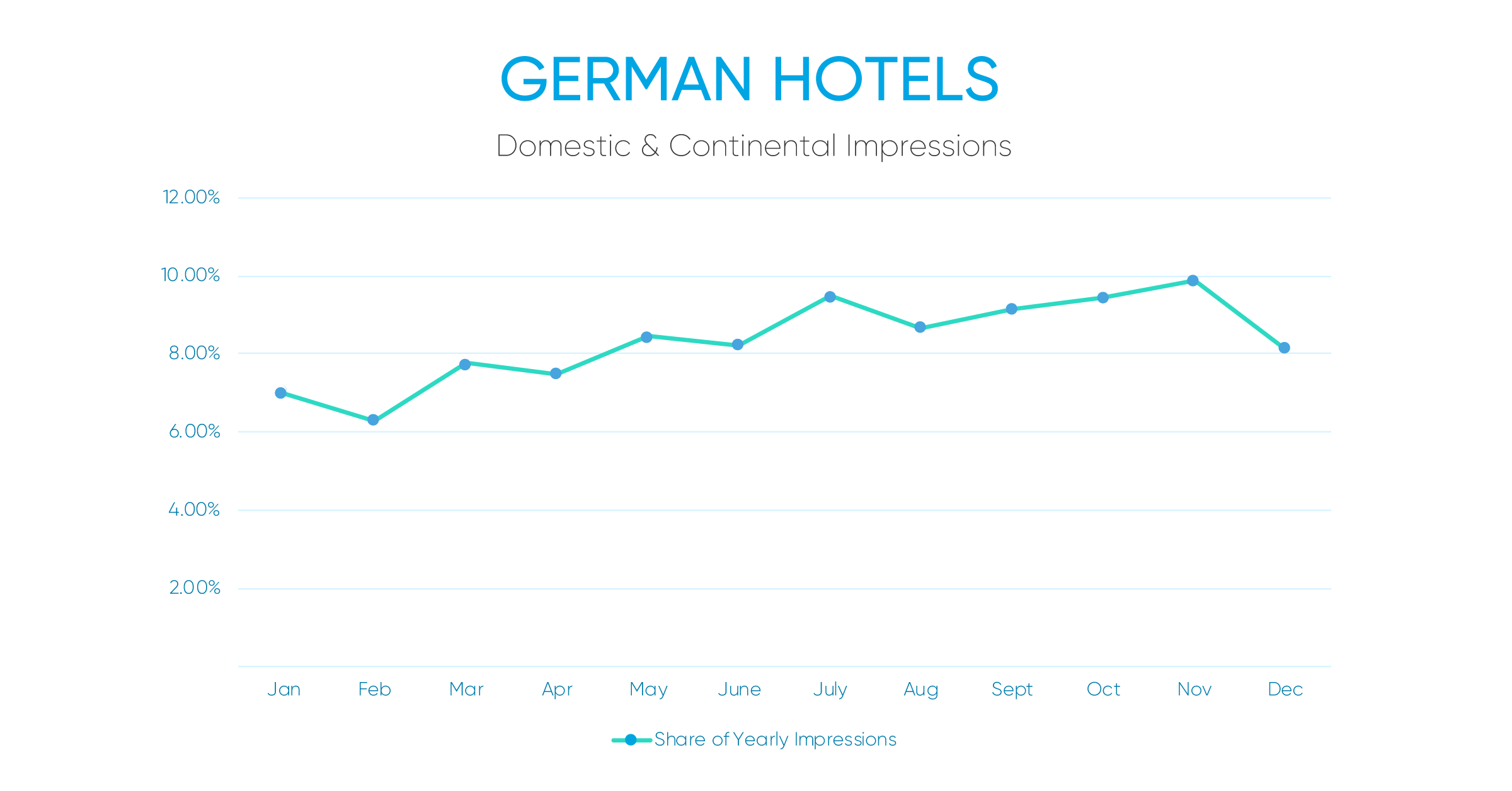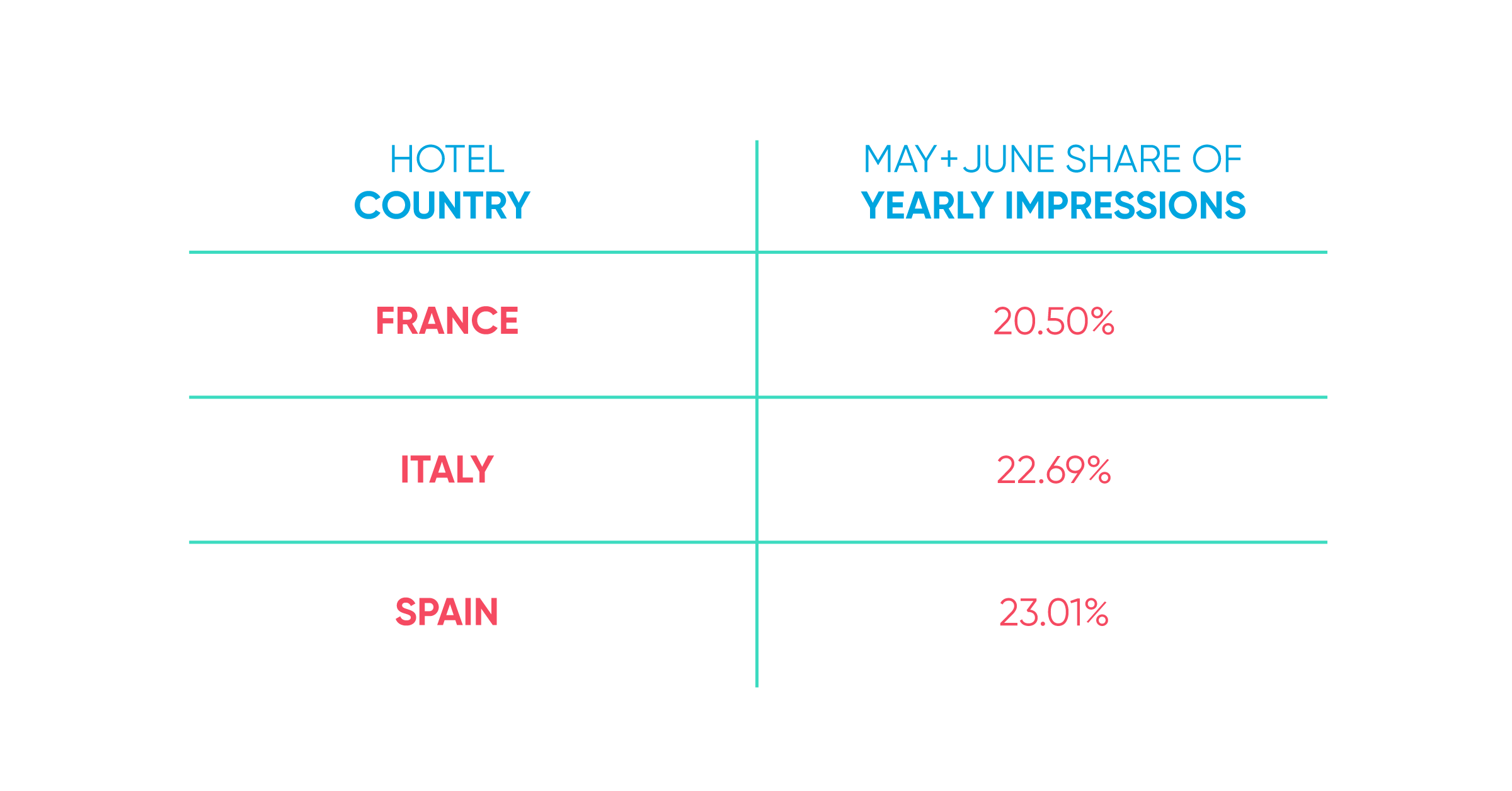
When preparing a budget for the fiscal year, hotel marketers in Europe should pay close attention to seasonality and the type of prospective guests that book during each season.
NB: This is an article from Koddi
While it is intuitive to assume that summertime is the optimal season to spend your marketing budget, keep in mind that leisure and business travelers often follow divergent trends. With the objective of better understanding European seasonality trends, our team assessed 2019 booking data to answer the following questions:
- Who is traveling during each season?
- How can hoteliers and OTAs alike react to seasonal trends?
- How should hotel marketers best allocate their yearly budget?
Europe has the highest rate of domestic and continental travel in the world. In our analysis of the European travel industry, we decided to focus on the “big five” markets: Germany, the United Kingdom, France, Italy, and Spain. Seasonality undoubtedly varies by the type of traveler, which is why we encourage marketers to understand business and leisure travel more broadly.
Business Travel and the Hotelier
Major hoteliers are often a big draw for businesses sending employees on trips, both domestic and abroad. Brand recognition, loyalty points, reliable customer service, standardized rooms, and prime locations all contribute to business travelers’ booking decisions. And unlike vacation planning, business travel is steadier year-round.
Hoteliers tend to see an increase in their metasearch impressions during the fall and summer months; this is particularly true for destinations such as Germany and Italy. According to internal Koddi data, major European hoteliers that garner thousands of business travelers per year see an increase in impressions in July, September, and October, with November not far behind. While summer is often a busy month for travel, leisure travelers tend not to search as often in the fall months, leaving marketers to enact strategies to attract the business traveler. The majority of searches in our “big five” countries came from domestic travelers. It is therefore important to adapt marketing efforts to travelers within the hotel country, as well as the likeliest visitors from outside the hotel country. We recommend examining your customer portfolio, pinpointing where your travelers are coming from, and initiating a strategy for yearly spend in those countries. It would also behoove hoteliers to allocate marketing spend away from low impression months, such as January or February, in favor of fall and summer, followed by spring.
Leisure Travelers and the OTA
Perhaps a hallmark of European travel, online travel agencies (OTAs) often capture leisure bookings by offering package deals. This is especially convenient for family travel, as booking a package bundles transport, hotel, insurance, and sightseeing all from a single website. While not as popular outside of Europe, OTAs make up the majority of their bookings in the summer, appealing to European travelers as they plan their holidays in those warmer months. So, how should marketers best allocate their budget to entice the leisure traveler, especially if they market for an OTA?
The answer again depends upon the hotel country. As with major hoteliers, the majority of OTA bookings are by travelers who live in the country of their holiday destination. Because Europe leads the travel world in continental bookings, marketers must pay attention to frequent travelers from around the region. All of the big five countries boasted June and July in their top three search impressions. It is essential for brands targeting leisure travelers to allocate the majority of their budget in the summer months and to capitalize on the summer holidays. Beach destinations are especially primed for these summer marketing efforts – and OTAs can further entice travelers with convenient package deals.
How Can Your Brand Capitalize on Seasonal Trends?
Budgeting effectively for an entire year is the key to predicting potential revenue and profits. By using seasonality data stored in your brand’s arsenal, you can capture every opportunity possible to make each season a success.
For hoteliers: A hotelier’s seasonality often attracts both business and leisure travelers. However, to capture the ever-growing business travel sector of the industry, pay close attention to travelers’ seasonal patterns.
For example, German hoteliers see searched impressions taking off in the fall months for both domestic travelers and continental travelers. While summer still accounts for a large percentage of yearly impressions, September, October, and November are all strong months. Typically low impression months, such as December, are relatively strong for German hotels.

Seasonality for French properties tells a slightly different story. While fall receives the second-highest share of searched impressions, summer accounts for over 9% higher impressions by season.

It is important to reiterate that for all countries in this study, domestic travel far and away received the highest number of impressions in each season.
For OTAs: Search impressions for OTAs follow a more familiar pattern. May and June are high impression months for OTAs. For Spain, France, and Italy, these months accounted for more than 20% of yearly impressions. Marketers should use the majority of their budget to capitalize on summer holidays in these destinations, particularly if packages are available.

Germany presented a slightly different case for OTAs. The highest share of impressions fell in February, January, and June. For marketers creating strategies for German hotels, focusing on travelers from Germany, Great Britain, and Spain would be most beneficial to their campaign during the winter months.
Let Data Be Your Guide
While it is easy to reduce seasonality to “spend more in summer” and “spend less in winter,” the data is much more varied than we might assume. The property portfolio, traveler location, as well as the season, are all important factors in deciding when and where to spend your marketing money.
While summer is the most optimal time for travel worldwide, the increase in business travelers within continental Europe presents brands with an opportunity to spend more in the fall months. And while winter is typically a downtime, some destinations see a spike in crucial opportunities.




